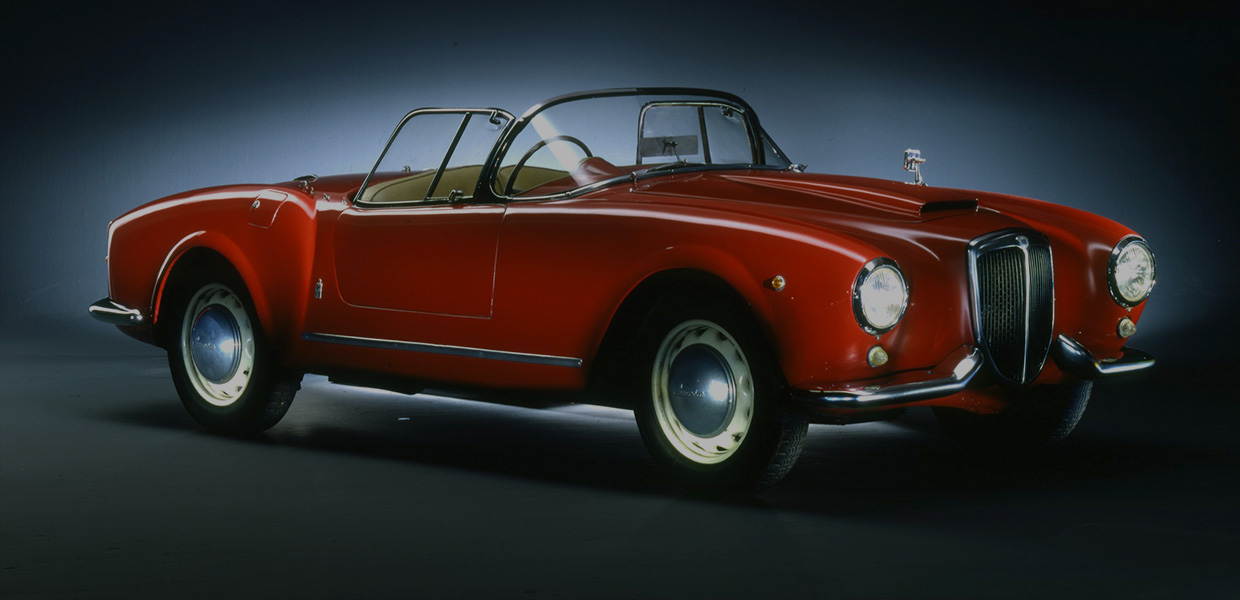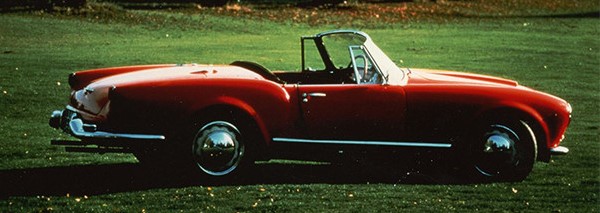
Designed by Pinin Farina and considered by many to be the most beautiful spider in the world , the B24 was presented at the Brussels Motor Show on January 15, 1955.
Two-hundred and forty units were made, with production ending in October 1955. The car had distinctive design details, such as the “wing-shaped” bumpers, doors without handles and panoramic windows and windscreen with American-style retracted pillars.
The engine was the legendary V6 designed by Francesco De Virgilio. It had a displacement of 2451cm3 and developed 118hp, driving it to a top speed of 180km/h. The later “Convertible America” version, which debuted at the Turin Motor Show in January 1956, appeared much more classic and comfortable: the engine was slightly less powerful and the doors were fitted with handles and winding windows. The production continued until the end of 1958. The Aurelia will be driven by Helio Ascari, descendant of the legendary Alberto who triumphed at the Mille Miglia in 1954 behind the wheel of the Lancia D24.
The crew consists of Vogue editor Carlo Ducci and Helio Ascari, a refined New York artisan who produces bespoke bicycles inspired by vintage cars, and whose surname hints at his lineage to the great driver Alberto Ascari. Just as stylish is their historic car, the B24, which a young Gianni Lancia created as a spider version of the Aurelia B20, and whose equally elegant shape made it hugely successful in the American market. By shortening the frame of the B20 4a series and with a few modifications to its 6-cylinder 2.451 cm3 engine, which were needed to fit it into a much lower bonnet, one of the most beautiful spiders of all time was born.
The first series was the only B24 that participated in the Mille Miglia and two versions were built: the Spider sometimes called the “America”, with canvas folding top, and the Convertibile with rigid roof. A total of 240 cars: were made: 59 with right-hand drive and 181 with left-hand drive.
The first series sported a panoramic windscreen (the biggest concession to American tastes), a long bonnet scoop and dual split bumperettes that accentuate the classic Lancia shield grille. The shape is very original: the centrally positioned cockpitand extended boot line are perhaps its most intriguing characteristics. The 118 HP engine, which was tuned down to 108-110 HP for the American market, delivered a top speed of 180 km/h (174 km/h for the America version). The gorgeous Turin-built spider was designed by the Pininfarina studio and equipped with rear wheel drive and a four-speed gearbox.
The first Mille Miglia race to feature an Aurelia B24 spider was the1956 edition, when the car driven by Bernardo Ferrari and bearing the number 506 failed to finish. The model achieved a much better result the following year, at the last edition of the Mille Miglia in 1957: Guido Mario Terzi finished 19th overall and, more importantly, came 7th in the Grand Touring +2000 class. It was a tremendous achievement, considering that the six GTs that finished ahead of the B24 were Ferrari 250s with 3000 cm3 engines. Ranked seventh in its class, the Aurelia B24 Spider beat another three Ferrari and a Ford Thunderbird, while in the overall ranking, it outperformed the BMW 502, Alfa Romeo 1900 SS, Fiat 8V Zagato, Triumph, numerous Porsches and a complete lineup of agile Alfa Romeo Giulietta Sprint Veloce models.
Mille Miglia cars are eminently charming and always excite great interest among the enthusiastic spectators, but the Aurelia B24 Spider in particular is certain to turn heads again when it glides past the crowds.

LANCIA AURELIA B24 SPIDER – 1955
- ENGINE………….V6 Otto cycle, Anterior Longitudinal, 2451 cm³
- POWER…………..118 HP @ 5.300 rpm
- SPEED……………185 km/h
- WEIGHT…………1115 kg
- DESIGN………….Pinin Farina
- BODY……………..Spider
The ’50s saw the reinforcement of the Turin-based constructor’s world-famous blend of elegance and sportiness The Lancia style was beautifully expressed in the memorable Aurelia B20 GT, a berlinetta with refined, powerful mechanics, from which the splendid Aurelia B24 Spider was derived.
In 1954 Pinin Farina – who had already helped to shape the lines of the Aurelia Granturismo – “dressed” the mechanics of the B20 to create an equally elegant spider, withlines that immediately proved a great success on the American market. By shortening the frame of the B20 4th series and with a few modifications to its 6-cylinder 2,451 cc engine, needed to fit it underneath a much lower bonnet, one of the most beautiful spiders of all time was born.
In just 1955, a total of 240 Aurelia B24 Spider cars were built: 59 with right-hand-drive and 181 with left-hand (with code B24S, the “S” standing for “sinistra”, or “left”). The Spider sported a long bonnet scoop and dual split “wing” bumperettes at the front, accentuating the classic shield grille, the most emblematic Lancia feature. The car’s basic layout was very original: the cockpit was virtually central, between the extended boot and the bonnet. The elegant B24 Spider’s distinguishing characteristics also included its low doors, leaving room for a high sill with a stylish chrome trim line. The design’s purity was further heightened by the absence of external door handles. On the inside, the dashboard carried three circular instruments, with the large speedometer in the middle, above the steering column. Another exquisite feature was the fine wooden steering-wheel with three aluminium spokes.
The 118 HP engine, tuned down to 108-110 HP for the American market, gave the magnificent rear-wheel drive Turin-built spider, with four-speed gearbox, a top speed of 180 km/h.
In 1956, with the advent of the 5th and 6th series of the B20, the B24 inherited the engine upgrade from 110 to 120 HP, with changes to the bodywork: the Convertible version was also launched.
The bonnet air scoops became more slender and the American-style panoramic windscreen was replaced by a more conventional type with almost vertical A-pillars. The deeper doors, now with handle, were fitted with adjustable windows and wing windows.The bumpers were also modified, as the split bumperettes were replaced with continuous, more wrap-around bumpers, like those on the Coupé B20 GT. The dashboard was simplified and now contained only two instruments, either side of the steering column.
As for the Spider cars, the Convertible chassis numbers followed that of the “sister” B20 units, and the car went out of production in 1958, after 150 units of the Aurelia B24 5th series and 371 of the 6th series had been built: all 512 only with left-hand drive.The great popularity enjoyed by this Lancia, rated one of the most elegant “open-tops” of all time, was reinforced by its use in film.
In Dino Risi’s 1962 masterpiece “The Easy Life”, a young Vittorio Gassman drives an Aurelia B24 Convertibile with dash and daring throughout the movie, making it one of the stars of the plot right through to the dramatic finale.

You must be logged in to post a comment.